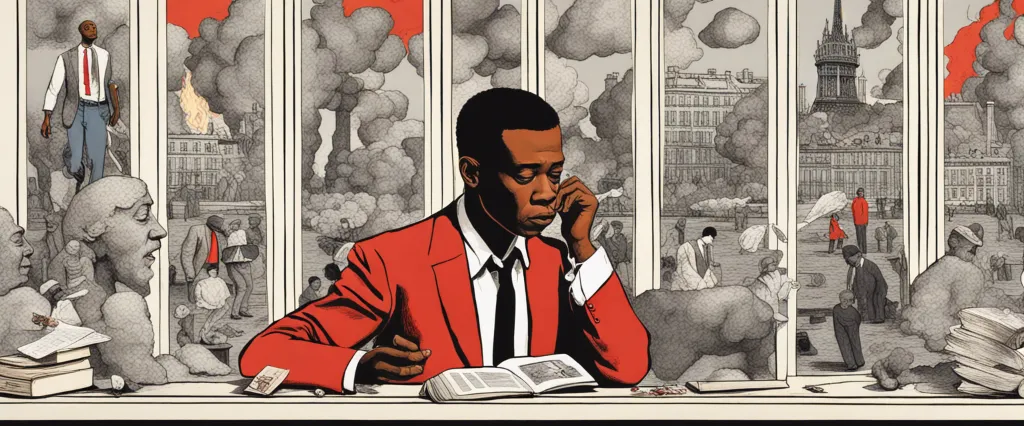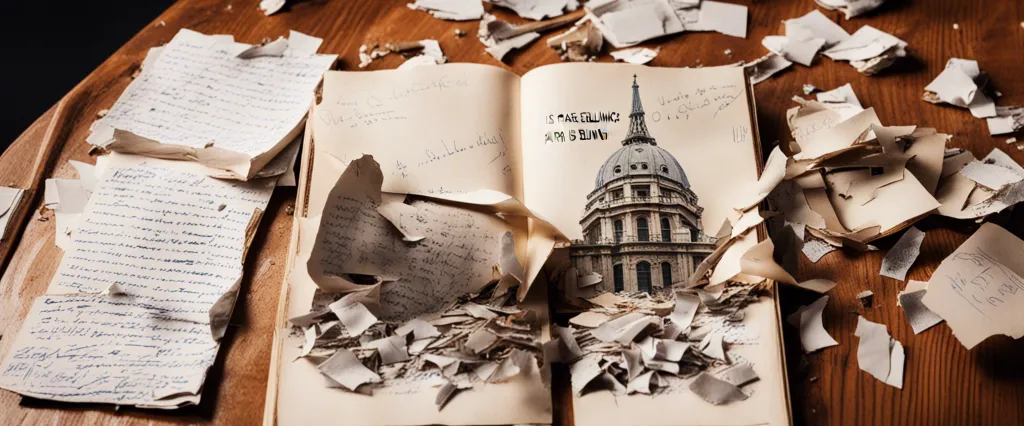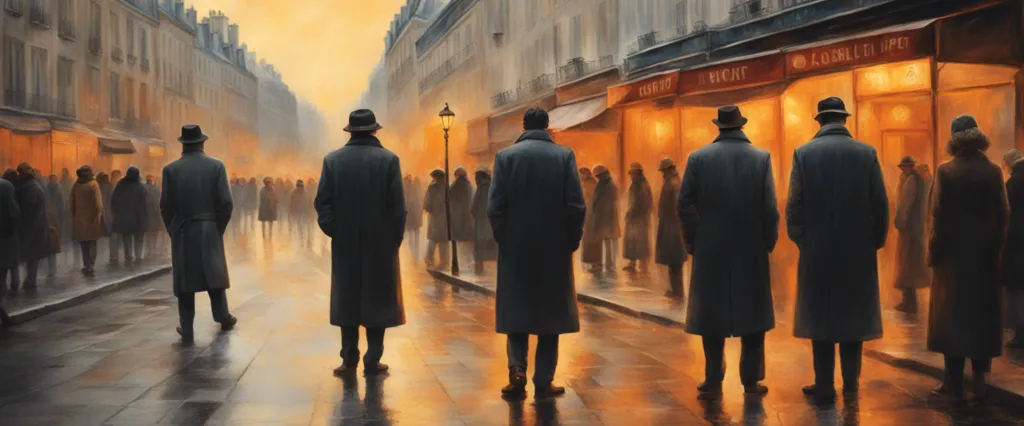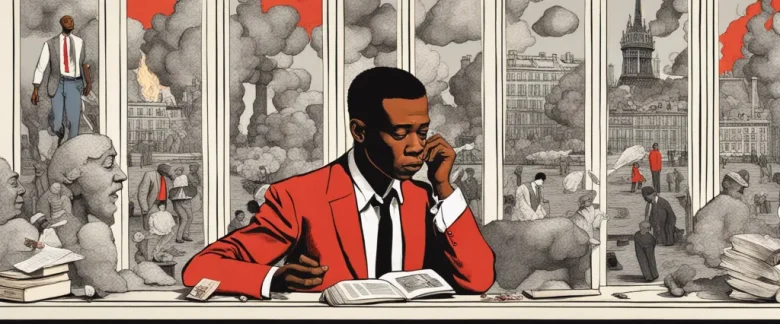
In the gripping historical account “Is Paris Burning,” co-written by Larry Collins and Dominique Lapierre, the authors meticulously dissect one of the most pivotal moments of World War II: the liberation of Paris from German occupation. In a masterful narration filled with suspense and vivid characters, Collins, a renowned American journalist and author, alongside Lapierre, a distinguished French journalist and author, meticulously reconstructs the compelling events that unfolded during the summer of 1944. With their combined expertise and exhaustive research, they shed light on the astonishing acts of courage, determination, and sacrifice demonstrated by both Resistance fighters and Allies, who halted Hitler’s plan to destroy the city before its liberation.
Chapter 1: Prelude to Destruction
Chapter 1 of “Is Paris Burning?” by Larry Collins sets the stage for the imminent destruction that Paris faced during World War II. The chapter begins with a focus on Adolf Hitler, the German leader, and his plan to evacuate and demolish Paris rather than allow the city to fall to the advancing Allied forces.
The chapter reveals Hitler’s frustration and anger towards Paris, for he considered it a symbol of decadence and the resistance against his Nazi regime. Hitler appointed General Dietrich von Choltitz as the military governor of Paris, entrusting him with the task of destroying the city in the event of an Allied invasion.
The narrative then shifts to the Allied perspective, specifically that of General Charles de Gaulle. De Gaulle is portrayed as a staunch French patriot, determined to liberate France and restore its honor. He is aware of the German threat to destroy Paris, and he believes that Parisians should be prepared to fight for their city.
Collins describes the growing tension within the city as rumors of the imminent German destruction circulate. Meanwhile, the French Resistance, led by Henri Rol-Tanguy, is secretly organizing its efforts to sabotage the German forces and aid the Allies in their liberation of Paris.
The chapter concludes with Hitler’s order to von Choltitz to destroy Paris if it cannot be held. Von Choltitz, a seasoned soldier torn between his loyalty to Hitler and his own conscience, ponders the devastating consequences of such an act.
Overall, Chapter 1 serves as an introduction, portraying the contrasting perspectives of the German occupiers, the French Resistance, and the imminent threat hanging over Paris. It sets the stage for the forthcoming narrative of the battle for the soul of Paris and the struggle to prevent the destruction of the city.
Chapter 2: The Occupation Begins
Chapter 2: The Occupation Begins of the book “Is Paris Burning?” by Larry Collins focuses on the period when Germany launched its invasion of France in 1940 and subsequently occupied Paris. The chapter delves into the difficult and tumultuous days that Parisians experienced under German rule.
The chapter starts by highlighting the initial shock and disbelief that gripped the French population as they realized the true extent of the German invasion. The French army, woefully unprepared and lacking morale, crumbled before the German forces, leading to a swift and devastating defeat. As the Germans advanced towards Paris, French authorities and citizens scrambled to protect important artworks and cultural treasures.
Upon occupation, the occupying German forces imposed strict rules and regulations on Parisians. Curfews were enforced, and citizens were required to carry identification documents at all times. The presence of German troops was ubiquitous, leading to a constant underlying fear among the population. Collaborators with the Germans emerged, taking advantage of the circumstances, while others faced imprisonment or death for their resistance efforts.
The chapter also delves into the plight of the city’s Jewish population, detailing the discrimination and persecution they endured under the occupation. Jewish citizens were marginalized, their rights stripped away, and they faced the threat of deportation and extermination.
Despite the challenges and oppression, the chapter also highlights the resilience and bravery of Parisians who formed resistance networks and engaged in acts of sabotage against the German occupation. These resistance fighters worked secretly and risked their lives to aid their fellow citizens and undermine the German authorities.
Overall, Chapter 2 provides a glimpse into the arrival and early days of German occupation in Paris, depicting the fear, oppression, resistance, and courage of the Parisian population as they navigated through this dark and turbulent period in their city’s history.
Chapter 3: The Resistance Takes Shape
Chapter 3 of “Is Paris Burning” by Larry Collins is titled “The Resistance Takes Shape.” In this chapter, Collins provides a detailed account of the development and organization of the French Resistance movement during World War II.
The chapter begins by chronicling the aftermath of the German occupation of France in 1940, which left many French citizens feeling defeated and helpless. However, a small group of individuals, dissatisfied with their capitulation, began quietly organizing to resist the German occupation. They formed clandestine networks, with each group focusing on a specific region or city, aiming to disrupt German operations and gather intelligence.
Collins introduces us to key figures in the resistance, such as Jean Moulin, who would later become a unifying force in the movement, and Colonel Rémy, who coordinated resistance activities in the southern part of France. These individuals and their allies worked tirelessly to build an extensive network of spies, saboteurs, and fighters.
Resistance members faced immense challenges, as the Germans were determined to crush any opposition. The chapter depicts various acts of sabotage, such as destroying communication lines and blowing up key infrastructure, carried out by these brave individuals.
Collins also explores the complex dynamics within the resistance movement. Some factions prioritized political ideologies, while others focused solely on military resistance. Despite internal disputes and occasional rivalries, the common goal of liberating France from German control united them.
The chapter concludes with the turning point of the resistance movement—the merger of different factions into a unified entity. Jean Moulin successfully brokered an agreement to merge various resistance networks under one umbrella organization: The National Council of the Resistance (CNR). This merger brought together different talents, resources, and expertise, boosting the resistance’s capabilities and effectiveness in their fight against the Germans.
Overall, Chapter 3 of “Is Paris Burning” captures the determination and courage of the individuals who formed and united the French Resistance movement, working diligently to undermine German occupation and pave the way for the liberation of Paris.
Chapter 4: Hitler’s Orders and the Liberation Plan

Chapter 4: Hitler’s Orders and the Liberation Plan of “Is Paris Burning?” by Larry Collins provides a detailed account of Adolf Hitler’s direct orders to General Dietrich von Choltitz, the German military governor of Paris, during World War II. It also discusses the liberation plan orchestrated by the French Resistance and the Allies as they prepared to free the city from Nazi control.
In this chapter, Collins recounts Hitler’s determination to destroy Paris rather than let it fall into enemy hands. The Führer commanded General von Choltitz to carry out a scorched-earth policy and level the French capital. However, von Choltitz hesitated to carry out these orders due to his personal attachment to the city, its cultural heritage, and its historical significance. This hesitation allowed an opportunity for Resistance members and Allied officials to plan the liberation of Paris.
Collins highlights the efforts of Resistance leader Henri Rol-Tanguy and his comrades, who managed to communicate with the London-based Free French government. Under the leadership of General Charles de Gaulle, plans were put in motion to free the city. The French Resistance coordinated their actions from within Paris, gathering intelligence, arming themselves, and building barricades in anticipation of the approaching liberation.
Simultaneously, the Allies were advancing towards Paris, and the collaboration between the French and American forces became crucial. Collins describes the close cooperation between General Jacques Leclerc, who commanded the French 2nd Armored Division, and General George S. Patton, the renowned American tank commander. Their objective was to liberate Paris as quickly as possible, preventing the Germans from carrying out Hitler’s orders.
Overall, this chapter provides an overview of Hitler’s destructive intentions for Paris, the struggle within the German ranks, and the coordinated efforts of the French Resistance and the Allies to liberate the city. It sets the stage for the impending battle and emphasizes the importance of the upcoming events in deciding the fate of Paris during World War II.
Chapter 5: The City of Light Under Siege
In the book “Is Paris Burning” by Larry Collins, Chapter 5 focuses on the city of Paris during the German occupation in 1944. As Allied forces advance towards France, the German Army, under the command of General Dietrich von Choltitz, prepares to defend Paris against the impending liberation.
The chapter starts by describing the dire situation within the city. Parisians endure constant air raids, bombings, and shortages of food and supplies. The occupying German forces enforce strict control over the city’s population, imposing curfews and carrying out brutal reprisals for resistance activities.
Resistance movements, such as the French Forces of the Interior (FFI), intensify their efforts to undermine German control and liberate the city. Led by General Charles de Gaulle, the FFI prepares for a possible uprising, aiming to rally the Parisians and join forces with the advancing Allied troops.
Meanwhile, General von Choltitz receives contradictory orders from higher-ranking German officials. Adolf Hitler wants him to destroy Paris completely, while other commanders urge him to defend it at all costs. Von Choltitz becomes increasingly torn between his loyalty to the Nazi cause and his personal moral dilemma. Despite his initial commitment to Hitler’s order, doubts start to arise within him.
Within the resistance movement, different factions debate how to proceed. Some argue for immediate insurrection, while others fear the devastating consequences for the city’s civilian population. Their plans become more cohesive when the FFI receives news of the imminent arrival of Allied troops, boosting their confidence in a successful uprising.
As tensions rise in the city and the date of liberation approaches, the chapter ends with Paris poised on the brink of a dramatic turning point. It sets the stage for the following chapters, where the fate of Paris hangs in the balance, and the ultimate decision of General von Choltitz will determine whether the city will be saved or destroyed.
Chapter 6: The Battle for Liberation
Chapter 6 of “Is Paris Burning” by Larry Collins dives into the intense battle for the liberation of Paris during World War II. Taking place in August 1944, this chapter offers a detailed account of the events that unfolded during the liberation campaign.
The chapter begins with a description of General Dietrich von Choltitz, the German military governor of Paris responsible for executing Adolf Hitler’s order to destroy the city if it fell into enemy hands. Meanwhile, the French Resistance, led by Colonel Pierre Billotte, is diligently working to coordinate an uprising within the city.
As the Allied forces approach Paris, tensions rise among the German hierarchy. Hitler feels betrayed by the hesitation of the military personnel in carrying out his destructive orders, which further fuels von Choltitz’s determination to fulfill his duty. However, von Choltitz rather reluctantly begins to question the ethics of such an act but remains loyal to his duty until the end.
On the side of the French, General Leclerc and his Free French armored division, along with the American 4th Infantry Division, spearhead the mission to liberate Paris. The book details the challenging process of reaching the city, facing fierce German resistance, and overcoming multiple obstacles along the way.
At the same time, the French Resistance members are engaged in various activities to sabotage German communication and transportation, further contributing to the Germans’ chaotic and compromised position. The chapter highlights the crucial role played by the Parisians themselves, as they join the fight and create barricades to delay the German forces and allow the Allies to advance towards the city center.
The chapter concludes with the dramatic and heroic liberation of Paris on August 25, 1944. The French flag is raised over the Eiffel Tower, symbolizing the end of the Nazi occupation. However, the book emphasizes the human cost of this battle, as both sides suffer significant casualties, and Paris is left in ruins.
In summary, Chapter 6 of “Is Paris Burning” provides a vivid account of the tense battle for the liberation of Paris, highlighting the efforts of the French Resistance, the challenges faced by the Allied forces, and the internal struggles of the German command. It showcases the resilience and determination of the French people in reclaiming their city, while reminding readers of the heavy price paid for freedom.
Chapter 7: The Liberation of Paris
Chapter 7: The Liberation of Paris of the book “Is Paris Burning” by Larry Collins focuses on the events leading up to the liberation of Paris from German occupation during World War II.
The chapter begins with the Allied forces, led by General Dwight D. Eisenhower, advancing through France after the successful D-Day landings. The French Resistance, particularly the Parisian underground network, becomes increasingly active, carrying out sabotage operations and gathering intelligence to aid the incoming Allies. In Paris, the Resistance, under the leadership of Henri Rol-Tanguy and Jacques Chaban-Delmas, works to unite various factions and assemble a formidable force to assist the Allies when they arrive.
General Charles de Gaulle, the leader of the Free French, becomes increasingly concerned that the Allies will bypass Paris due to fears of excessive casualties and focus on other strategic objectives. De Gaulle believes that the liberation of the capital city is crucial for his claim to legitimacy as the leader of France. He demands that Eisenhower ensure the liberation of Paris as soon as possible.
As the Allies approach Paris, German officers such as General Dietrich von Choltitz prepare to defend the city. However, von Choltitz secretly contemplates surrendering to the Allies rather than completely destroying Paris, as ordered by Hitler. Discussions take place between von Choltitz and Swedish consul Raoul Nordling, who attempts to convince the German general to spare the city.
On August 25, 1944, the Allies finally reach the outskirts of Paris. The French Resistance rises up and takes control of key strategic locations in the city, erecting barricades and engaging in skirmishes with German forces. General von Choltitz, recognizing the futility of further resistance, surrenders the city to the Resistance, and de Gaulle triumphantly visits Paris to claim victory.
This chapter explores the intense suspense, political calculations, and courageous actions that ultimately led to the liberation of Paris and symbolized a turning point in France’s fight against Nazi Germany.

Chapter 8: Rebuilding and Remembering
Chapter 8: Rebuilding and Remembering of the book Is Paris Burning by Larry Collins delves into the aftermath of World War II and the challenges faced by the people of Paris as they rebuild their beloved city. The chapter highlights the resilience and determination of both the citizens and the city’s leaders to restore Paris to its former glory.
The chapter begins with General Choltitz, the German military governor, realizing that resistance is still prevalent among the Parisians despite their initial submission. He decides to tighten his control over the city by imposing curfews, eliminating communication channels, and implementing a curtailment of provisions. He fears that the French resistance might have plans to destabilize his control by launching guerilla warfare.
However, despite German attempts to repress the spirit of the Parisians, the chapter also focuses on the rebirth of the city. Jacques Chaban-Delmas, the leader of the French Forces of the Interior, works tirelessly to organize and coordinate the reconstruction efforts. He rallies the citizens and receives aid from various nations, particularly the supplies and equipment provided by the Americans.
The chapter further explores the importance of symbolism in the reconstruction process. The main symbol of Paris, the Eiffel Tower, emerges unscathed from the war and becomes a powerful emblem of hope and resilience. Its restoration symbolizes the Parisians’ determination to rebuild their city.
Furthermore, the chapter highlights the vital role played by French intellectuals, writers, and artists in shaping post-war Paris. They believe that their creative output can contribute to the healing process and help the city regain its cultural and intellectual prominence.
In summary, Chapter 8 of Is Paris Burning portrays the challenges faced by the citizens of Paris in rebuilding their city after World War II. It showcases their resilience, the restoration efforts led by Jacques Chaban-Delmas, the symbolic significance of the Eiffel Tower, and the role of intellectuals in reviving the cultural and intellectual spirit of the city.
After Reading
In conclusion, “Is Paris Burning” by Larry Collins masterfully recounts the historical events surrounding the liberation of Paris during World War II. The book provides a gripping narrative that highlights the bravery and resilience of the French people while shedding light on the strategic decisions made by the Allies. By effectively blending personal accounts, meticulous research, and rich storytelling, Collins brings this pivotal moment in history to life. Readers are left with a deep appreciation for the sacrifices made and the indomitable spirit of the Parisians who fought for their city’s freedom. Overall, “Is Paris Burning” is a remarkable testament to the triumph of the human spirit in the face of overwhelming odds.
1. The Great Gatsby” by F. Scott Fitzgerald – Set in the Roaring Twenties, this iconic novel offers a stunning portrayal of the elusive American Dream and the corrupting influence of excess and wealth. Explore the timeless themes of love, disillusionment, and the pursuit of a meaningful life through Fitzgerald’s lyrical prose.
2. “To Kill a Mockingbird” by Harper Lee – This Pulitzer Prize-winning novel tells the story of Scout Finch as she navigates the racial prejudices and injustices in 1930s Alabama. With beautifully crafted characters and a powerful exploration of morality and empathy, Lee’s masterpiece continues to resonate with readers of all ages even today.
3. 1984″ by George Orwell – A chilling dystopian novel that paints a haunting portrait of a totalitarian society where individualism is crushed and government control is absolute. Orwell’s thought-provoking exploration of surveillance, manipulation, and the erosion of truth remains a powerful warning against the dangers of authoritarianism.
4. Pride and Prejudice” by Jane Austen – Delve into 19th-century England with this timeless novel that explores love, class, and societal expectations. Follow the spirited Elizabeth Bennet as she navigates the complexities of relationships, familial duty, and cultural norms in Austen’s signature wit and charm.
5.”The Alchemist” by Paulo Coelho – In this enchanting allegorical novel, Coelho takes readers on a journey of self-discovery and spiritual awakening. Follow Santiago, a young Andalusian shepherd, as he embarks on a quest to find his personal legend, facing challenges and magical encounters along the way that teach invaluable life lessons.



